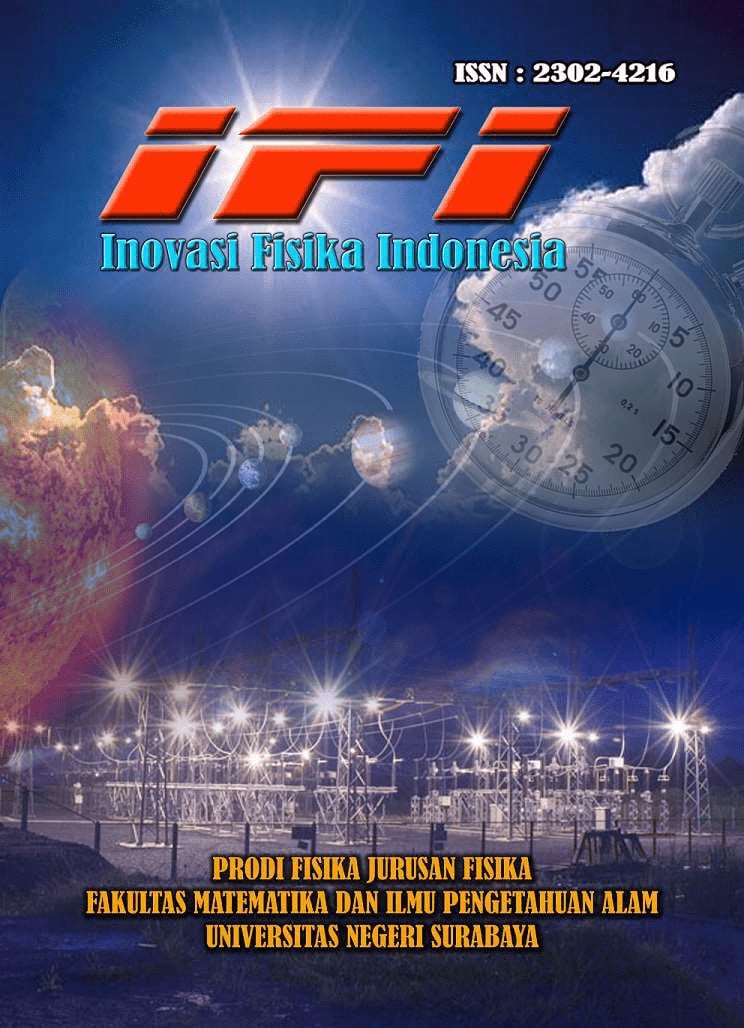PEMODELAN KOMPUTASIONAL SIFAT MEKANIK THIN FILM BERBASIS PEKTIN KULIT DURIAN
DOI:
https://doi.org/10.26740/ifi.v14n2.p209-215Keywords:
Pektin kulit durian, thin film, simulasi numerik, distribusi tegangan, peak stress, stress distribution, numerical simultion, Durian rind pectinAbstract
Abstrak
Pektin yang diekstrak dari kulit durian merupakan salah satu bentuk pemanfaatan limbah biomassa berpotensi tinggi sebagai material ramah lingkungan, khususnya untuk aplikasi kemasan pangan biodegradable. Pada penelitian ini dilakukan simulasi numerik berbasis COMSOL Multiphysics untuk menganalisis perilaku mekanik film tipis pektin kulit durian di bawah berbagai kondisi pembebanan. Studi dilakukan dengan membangun model tiga dimensi (3D) film tipis, kemudian pemetaan tegangan von Mises, analisis distribusi tegangan, serta evaluasi nilai tegangan maksimum (peak stress), minimum, dan rata-rata. Hasil simulasi menunjukkan distribusi tegangan tidak merata di seluruh volume film, melainkan terkonsentrasi pada tepi dan sudut akibat efek geometri. Nilai peak stress berfluktuasi terhadap waktu dan cenderung meningkat pada siklus pembebanan tertentu, yang berimplikasi pada potensi inisiasi retakan di area kritis. Meskipun demikian, sebagian besar area film masih berada dalam kondisi elastis, sehingga deformasi bersifat reversibel. Analisis ini menegaskan bahwa ketahanan jangka panjang film tipis pektin dipengaruhi oleh kombinasi sifat intrinsik material, kondisi batas, serta variasi pembebanan. Temuan ini memberikan dasar penting bagi pengembangan material kemasan berbasis pektin kulit durian yang lebih andal melalui modifikasi struktur maupun penambahan aditif penguat.
Abstract
Pectin extracted from durian rind represents a promising valorization of biomass waste with potential applications as an eco-friendly material, particularly for biodegradable food packaging. In this study, a COMSOL Multiphysics-based numerical simulation was conducted to investigate the mechanical behavior of durian rind pectin thin films under various loading conditions. A three-dimensional (3D) thin-film model was developed, followed by von Mises stress mapping, stress distribution analysis, and evaluation of maximum (peak stress), minimum, and average stress values. The results revealed that stress distribution was not uniform across the film volume but concentrated along the edges and corners due to geometric effects. Peak stress exhibited temporal fluctuations and tended to increase during specific loading cycles, indicating a high probability of crack initiation in critical regions. Nevertheless, the majority of the film remained within the elastic regime, allowing reversible deformation. This analysis highlights that the long-term reliability of durian pectin thin films is strongly governed by the interplay of intrinsic material properties, boundary conditions, and loading variations. The findings provide a scientific basis for further optimization of durian rind pectin films through structural modification or reinforcement additives to enhance their performance as sustainable packaging materials.
Downloads
References
Ahmad, R., Ramli, N. and Abdullah, A. 2023. Extraction and characterization of pectin from durian rind for potential application as biopolymer material. Journal of Polymers and the Environment,
Chanshotikul, N., Rachtanapun, P. and Jantanasakulwong, K. 2021. Pectin from durian rind: Extraction, characterization, and potential applications in food packaging. International Journal of Biological Macromolecules,
Sudaryati, N., Putra, Y. P. and Hidayat, R. 2020. Utilization of durian rind waste as a new source of pectin: Extraction and physicochemical properties. Indonesian Journal of Chemistry, pp. 1201–1210.
Dirpan, A., Deliana, Y., Ainani, A. F., Irwan and Bahmid, N. A. 2024. Exploring the potential of pectin as a source of biopolymers for active and intelligent packaging: A review. Polymers, doi:10.3390/polym16192783, pp. 2783.
Xiang, T., Yang, R., Li, L., Lin, H. and Kai, G. 2024. Research progress and application of pectin: A review. Journal of Food Science, doi:10.1111/1750-3841.16971, pp. 6985–7007.
Li, D. Q., Li, J., Dong, H. L., Li, X., Zhang, J. Q., Ramaswamy, S. and Xu, F. 2021. Pectin in biomedical and drug delivery applications: A review. International Journal of Biological Macromolecules, doi:10.1016/j.ijbiomac.2021.07.140, pp. 49–65.
Li, S. et al. 2020. Modeling and simulation of mechanical properties of biopolymer-based thin films using COMSOL. Computational Materials Science, doi:10.1016/j.commatsci.2020.109472, pp. 109472.
Gupta, S. and Ahuja, V. 2020. Thermal and mechanical properties of pectin films: A simulation study using COMSOL. Carbohydrate Polymers, doi:10.1016/j.carbpol.2019.115859, pp. 115859.
Zhang, Y. and Dong, X. 2022. Computational study of stress distribution and deformation in biopolymer thin films. Journal of Applied Polymer Science, doi:10.1002/app.51435, pp. 51435.
Shen, W. et al. 2021. Numerical simulation of mechanical properties in pectin films: Stress-strain analysis. Materials Science and Engineering: C, doi:10.1016/j.msec.2020.111437, pp. 111437.
Zhou, Z. and Zhang, X. 2024. The effect of film thickness on the mechanical properties of biopolymer films: A COMSOL-based study. Computational Materials Science, doi:10.1016/j.commatsci.2021.110641, pp. 110641.
Liu, R. et al. 2021. Cross-linking agents for strengthening pectin films: A modeling and experimental study. Biomacromolecules, doi:10.1021/acs.biomac.0c01412, pp. 951–960.
Khan, M. et al. 2021. Stress-strain simulations of biopolymer films under mechanical loading conditions. Journal of Applied Polymer Science, doi:10.1002/app.50129, pp. 50129.
Zhang, S. et al. 2021. Influence of moisture content on mechanical properties of pectin films: A simulation approach. Carbohydrate Polymers, doi:10.1016/j.carbpol.2021.118332, pp. 118332.
Patel, A. and Sharma, A. 2023. Mechanical behavior of pectin-based films under stress: Experimental validation. Polymer Testing, doi:10.1016/j.polymertesting.2020.107200, pp. 107200.
Downloads
Published
How to Cite
Issue
Section
License
Copyright (c) 2025 Reffany Choiru Rizkiarna, Fajar Timur, Akbar Sujiwa, Primasari Cahya Wardhani

This work is licensed under a Creative Commons Attribution-NonCommercial 4.0 International License.
 Abstract views: 102
,
Abstract views: 102
, PDF Downloads: 60
PDF Downloads: 60








1.png)
